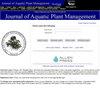American frogbit response to herbicides
IF 0.9
4区 生物学
Q3 MARINE & FRESHWATER BIOLOGY
引用次数: 0
Abstract
Limnobium spongia (frogbit) is a free-floating aquatic plant that can produce extensive floating mats causing negative ecological, social, and economic impacts that can harm aquatic fauna (i.e., dissolved oxygen depletion) and restrict human uses of water. Literature describing effective control measures for frogbit is minimal. Efficacy of high and low doses of seven foliar-applied herbicides (2,4-D, florpyraux-ifen-benzyl, flumioxazin, glyphosate, imazamox, imazapyr, and triclopyr) were evaluated in a mesocosm setting in the summers of 2018, 2020, and 2021. Both emergent and submersed frogbit biomass were reduced at least 99% by imazamox (0.56 and 1.11 kg ai ha1) and imazapyr (0.42 and 0.84 kg ae ha1) 8 wk after treatment (WAT) compared with nontreated reference plants. Triclopyr (6.71 kg ae ha1) reduced frogbit biomass 92% and flumioxazin (0.42 kg ai ha1) reduced biomass 87 to 93% compared with reference plants. 2,4-D (2.12 and 4.24 kg ae ha1), glyphosate (2.83 and 5.67 kg ai ha1), triclopyr (3.36 kg ae ha1), florpyrauxifen-benzyl (0.02 and 0.05 kg ai ha1), and flumioxazin (0.21 kg ai ha1) did not reduce frogbit biomass 8 WAT compared with reference plants. Future research should consider the efficacy of different herbicide combinations to control frogbit, as well as the role of diluent volume per unit area, especially with imazamox and imazapyr. Field studies also will be useful in determining whether the results observed in this study will translate to management of frogbit in natural settings.美国青蛙对除草剂的反应
海绵Limnobium spongia (frogbit)是一种自由漂浮的水生植物,可以产生广泛的浮垫,造成负面的生态、社会和经济影响,可能危害水生动物(即溶解氧耗尽)并限制人类对水的利用。描述青蛙有效控制措施的文献很少。在2018年、2020年和2021年夏季的中生态环境中,评估了高剂量和低剂量7种叶面施用除草剂(2,4- d、氟吡虫啉-苯甲醚、氟恶嗪、草甘膦、伊马唑莫、伊马唑吡和三氯吡)的效果。处理后8周,与未处理的对照植物相比,imazamox(0.56和1.11 kg / h1)和imazapyr(0.42和0.84 kg / h1)可使苗生和淹没生物量减少至少99%。与对照植物相比,三氯吡啶(6.71 kg / ha1)使生物量减少92%,氟恶嗪(0.42 kg / ha1)使生物量减少87%至93%。与对照植物相比,2,4- d(2.12和4.24 kg艾蒿1)、草甘膦(2.83和5.67 kg艾蒿1)、三氯吡虫啉(3.36 kg艾蒿1)、氟吡虫胺苯(0.02和0.05 kg艾蒿1)和氟恶嗪(0.21 kg艾蒿1)没有降低生物量8 WAT。今后的研究应考虑不同除草剂组合防治蛙病的效果,以及单位面积稀释剂体积的作用,特别是伊马唑莫和伊马唑吡尔。实地研究也将有助于确定本研究中观察到的结果是否将转化为自然环境中青蛙的管理。
本文章由计算机程序翻译,如有差异,请以英文原文为准。
求助全文
约1分钟内获得全文
求助全文

 求助内容:
求助内容: 应助结果提醒方式:
应助结果提醒方式:


